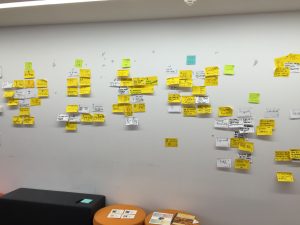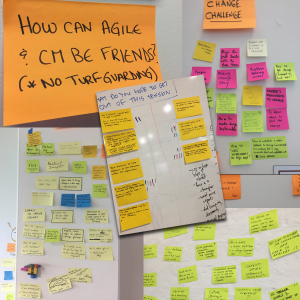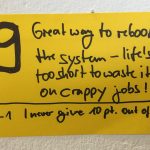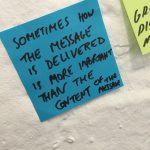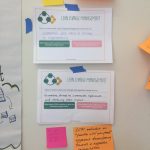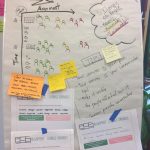A friend of mine asked me on twitter what my 3 main things I’ve learned teaching my Lean Change Agent workshops and what the main takeaways from attendees were.
It’s a bit hard to answer this in a tweet, or even a serious of tweets, so here goes.
How this Post is Constructed
- Context: it’s important to understand what triggered me to move away from agile, and into org change. It’s also important to understand what influenced thinking about org change differently.
- Some stats: how LCM came to be what it is today.
- What people who attend want, and what they’ve taken away
- What my lessons have been after traveling the world and delivering over 50 of these workshops
First, How Lean Change Agent Came to Be
About a decade ago I was an innocent bystander in a screaming match between our ‘senior’ agile coach and a senior manager. F-bombs and all. This was my first enterprise agile gig so I figured yelling and swearing at the client and acting like you’re smarter than everybody else in the company was what agile coaching was all about.
While at that gig, another more reasonable coach suggested I go to AYE. I did, and then I wrote this post. Then I created one of the first Live Lessons for Safari Books and InformIT (which is now Front Row Agile) about Agile Transformation.
Then I worked for the organization that the book is based on, wrote the first version in 2012 chapter by chapter on LeanPub and then re-wrote it for Happy Melly Express in 2014.
Torsten Scheller funded the book IndieGogo project, which meant he had the chance to organize the first workshop (which didn’t exist at the time). He brought me to Munich and after 2 workshops, asked if I’d consider licensing the content for other facilitators.
That’s the reader’s digest of my life from 2008 to 2014. The workshop developed over time by practicing what I preach. I used a big-visible wall, perfection game, and net promotor scores after each block of content to see what worked and what didn’t:
Attendees were asked to rate the content block from 0 to 10, with a comment why they gave it that rating. One person in Hamburg gave the workshop 2 ratings. She said for her (someone with a decade of experience in change, and formal OD or professional coaching training), it was a 4/10. For anyone else, a 9/10. (The sticky note is around here somewhere)
Additionally, I used an actions and insights wall for each content block so attendees could track their lessons throughout the 2-days to eventually come away with their one action they’d try.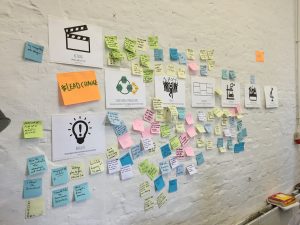
Next, Some Stats
What started with the intent of telling a great story, spawned a global movement:
- ~10,000 copies of Lean Change Management have been sold factoring in all distribution channels
- peaked at #6444 out of 8,000,000 books on Amazon, #198 in Leadership and Management
- LCM is available in German and soon to be available in French, Spanish and Chinese!
- ~2000+ people have attended workshops worldwide, mostly change consultants, coaches, agile coaches and mid-level managers/directors. Execs only attend if it’s a small company because this workshop isn’t an executive workshop.
- There are 42 facilitators delivering workshops worldwide
- 4.5/5.0 rating based on 37 reviews on Amazon.com (4.0/5.0 on Amazon.ca and 5.0/5.0 on Amazon.de)
- 4.04/5.0 rating based on 175 reviews, and 25 full-text reviews on Goodreads
- 63% increase in my ego
- 2500+ mailing list subscribers
- too many speaking events to count
- A bunch of LCM dedicated Meetup.com groups
- The inclusion of Lean Change Management in Harrisburg University’s change course
What People Want
At every workshop, I ask people to write down their change challenge:
I have 3 years of this data and these are the 2 main patterns:
- how do I get <those people> to do the change (or how do I overcome resistance, or motivate or engage people, or influence people, or something else related to our perception of how other people are reacting to the change)
- how do we use agile, lean startup, and lean tools in change management? (or other questions related to “what the Lean Change Management Framework” is about – BTW, I don’t call it a framework, method, tool, but just called it a ‘model’ in order to make it a thing. In reality, any model/method/framework/tool anyone has created is a documented and visual representation of how they see the world and how they work. I called it “the way Jason works“, it’s harder to sell and people need to know a collection of ideas is a ‘thing’ so there is social proof that there is something to those ideas.
There are a smattering of others, but generally, the change challenges centre around these topics.
What People Takeaway
First I’ll show who usually comes, and then what they’re takeaways generally are.
This workshop has generally attracted:
- Early Adopter, “Traditional” change people who know a lot about traditional change models (Kotter, Prosci are the most common) but very little about agile. This group generally shares the same mindset and mantra that “left-side agile manifesto” thinkers do and they’re wanting to bridge what they know and believe with lean and agile stuff.
- Agile Coaches who know a lot about agile (old world agile…as in values, principles, mindset…not the glut of agile processes that have evolved over the last decade) and very little about organiatioal change, or change management. This group believes in the purpose of LCM but desire some OD structure, models and ideas to be able to coach in the organizational layer.
- Managers/Directors/Employees: This group usually want an answer to a specific question like “how do I sell <this change> to my boss?”
- Reactionary “Traditional” change people: This group is similar to the first one I listed but they’ve been thrown into an agile, or digital transformation and have no idea what that is, or what to do. They might be given a title of ‘agile consultant’, or ‘agile change coach’ or something like that, but basically they’ve been thrown into the deep end of the pool and see this workshop as a lifeline.
Main takeaways:
- change has never been, and will never be a linear process, but that’s scary when you really think about it
- what you do as a change agent is the same, but how you do it if you’re applying agile/lean thinking is drastically different. (IE: change readiness assessments are always a good idea, but there is an infinite number of ways to facilitate meaningful conversations instead of using a 5-question survey)
- people without professional coaching backgrounds see how the tools in LCM help them do what coaches do (IE: storytelling canvases, change canvases, perspective mapping etc). Most take what they worked on in the workshop back to their organization
- most people take away a simplified, non-mumbo-jumbo way of explaining organizational change and change management (IE: putting a question like “what is the urgency to change?” on a canvas or in a survey is just about the dumbest thing you can do…normal people don’t talk, or think that way.)
- change always starts from you. Always. If you’re a linear, fixed-mindset thinker (which there is nothing wrong with, despite what you hear coming out of the agile community), you will really struggle with this concept but if you’re passionate about change, you’ll figure it out. (IE: if you make change about governance and process, that influences your change to follow that same path and it’s unlikely anything meaningful will come out of the change)
- people don’t resist change, they don’t even resist being changed….sometimes they think the change is just stupid so the takeaway is to always involve the people affected by the change into the design of it. Always. Jill Forbes said it best, “the people who write the plan, don’t fight the plan“
- Find catalysts who are in the ‘inner circle’. I call these Movers. As the change agent, your influence is limited unless you enlist the people who have strong relationships throughout the organization.
- Change resistance and the “70% of changes fail stat” are both nonsense and useless to talk about because neither help you move forward, they anchor you.
Perhaps most important, experienced change agents who share a similar belief as I get more out of my facilitation style and the stories I tell. That is, they know I am there to help them, challenge them when I need to, pull back when necessary, and they know the workshop is about them, and not me. They usually take that back to their organizations because sometimes we feel forced into push-based change because of the pressure from change sponsors and stakeholders.
Lastly, the small minority who don’t like the workshop (our average global rating from 1000+ online evaluations is 9.01/10.0) don’t like it because they aren’t given a set of instructions for when and how to use which tool, or an overall framework diagram. They are confused about how to start with LCM because in their world, they have to ask permission to use a “different method”, they usually have to present how it works, and they have a lot of baggage to unpack from previous experience, best-practice thinking and more.
Here are a few pictures of Insights people have had:
My Lessons
- wherever you live, whatever your company does, the problems are all exactly the same: people. Process can’t fix that.
- most change agents *instinctively know* how to do what they learn in the workshop, but now they have a global community and social proof that backs up what they believe, and it inspires them to take action. I try to do lean coffee sessions with previous attendees in my workshops so they can tell stories about what they tried after attending.
- most change agents are coming from a place of curiousity for how to better facilitate change
- There is a chasm of difference between North America and the rest of the world when it comes to a stance toward change management. North Americans are more likely to desire certifications, standards, best practices, and process, while outside of North America, people are more likely to want to find one small nugget to takeaway. Generally they are there to learn how to move change forward with clients or their organization versus improving their marketability as a change manager. Europeans generally engage more as well. If they don’t understand, or even agree, they speak up. North Americans generally smile, nod and give you a bad review.
- certification collectors do not enjoy the workshop (and generally don’t come after learning I do not certify people when they ask for PDU’s or other things.) – BTW, there’s nothing wrong with that, but I think we all know ‘certifying people’ after a 1 to 5 day workshop is just ridiculous, especially in change, agile and leadership. Intersting enough, I see some people calling themselves Certified Lean Change Agents.
- Perhaps the biggest takeaway for me is that change in our organizations follows the same patterns as societal change. It doesn’t matter what method, model, or framework you use, if you don’t know how to navigate the whitespace in the organization, find catalysts, and make use of informal influence networks, the change you’re working on will lead to superficial results at best.
- Ok, another big takeaway: there are thousands of people around the world who align with the stance of LCM and have created similar tools, and have had similar ideas. It’s that community I want to enable.
Jon, this is probably more detail than you were expecting, so hopefully, you (and other readers!) stuck with this post until the end. I wrote it in one sitting, didn’t read it, or change anything so everything just poured out. Hope it was useful!

